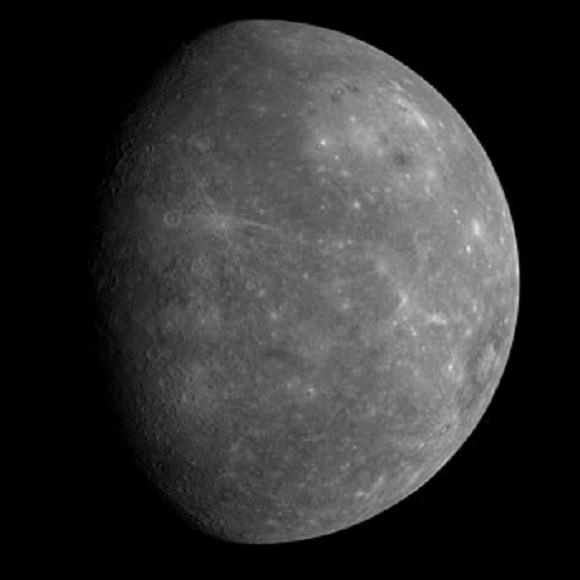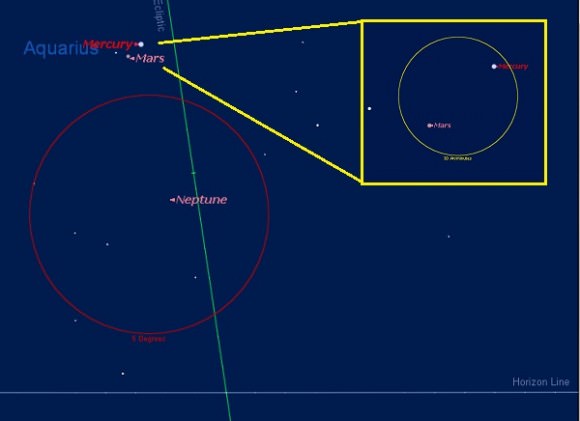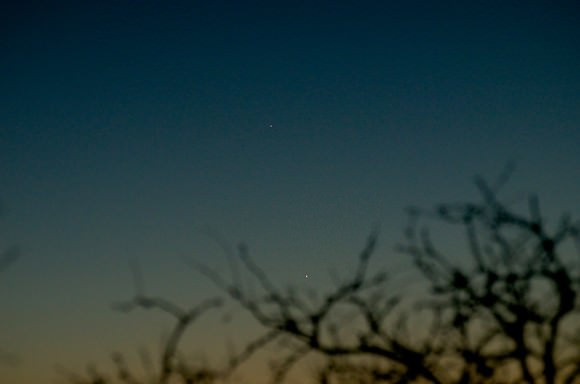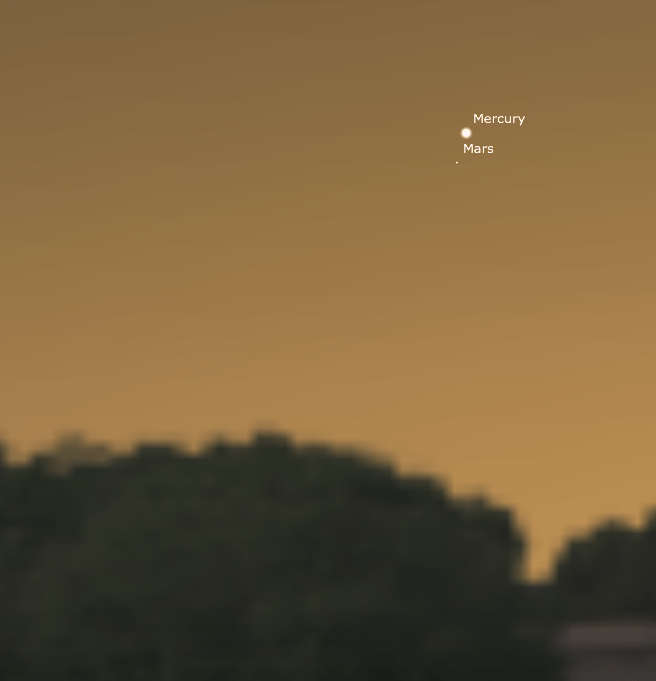[/caption]
The history of astronomy is littered with astronomical objects in the solar system that have fallen to the wayside. These include fleeting sightings of Venusian moons, inter-mercurial planets, and even secondary moons of the Earth.
While none of these observations ever amounted to true discoveries, this weekend gives observers and astrophotographers a unique chance to “mimic” a spurious discovery that has dotted astronomical lore: a visual “pseudo-moon” for the planet Mercury. This “moon illusion” will occur on February 8, 2013 during the closest conjunction of two naked eye planets in 2013. February offers a chance to see the fleeting Mercury in the sky, and this conjunction with Mars will provide the opportunity to see how Mercury would look in the night sky if it had a moon!
Mercury has been suspected of having moons before. On March 29th 1974, the Mariner 10 spacecraft became the first mission to image the innermost world up close. Mariner 10 mapped 40-45% of Mercury on 3 successive passes, revealing a pock-marked world not that different than our own Moon. But Mariner 10 also detected something more: brief anomalies in the ultra-violet spectrum suggestive of a moon with a 3 day period. For a very brief time, Mercury was thought to have a moon of its own, and NASA nearly made a press release to this effect. The spectroscopic binary 31 Crateris is now suspect in the anomalous readings. Still, the Mariner 10 observation made researchers realize the observations in the extreme UV were possible over interstellar distances.

Today, NASA has a permanent emissary orbiting Mercury with its MESSENGER spacecraft. MESSENGER first entered orbit around Mercury on March 18th, 2011 after a series of trajectory changing flybys. MESSENGER has filled in the map of the remainder of Mercury’s surface, with no signs of the anomalous “moon.” Interestingly, MESSENGER was also on the lookout for “Vulcanoids” (tiny asteroids interior to Mercury’s orbit; sorry, Mr. Spock) while enroute to its final orbital insertion. NASA even released an April Fool’s Day prank of a fake “discovery” of a Mercurial moon dubbed Caduceus in 2012.
But MESSENGER has made some fascinating true to life discoveries, such as sampling Mercury’s tenuous exosphere & the possibility of ice at its permanently shadowed poles. Lots of new features have been mapped and named on Mercury, following the convention of naming features after famous deceased artists, musicians and authors set forth by the International Astronomical Union. It’s amazing to think that we had no detailed views at the entire surface of Mercury until the 1970’s, although some ground-based professional observatories and even skilled amateurs are now doing just that.
Fast forward to this weekend. Mercury is just beginning its first apparition of six in 2013 this week and is currently visible low in the dusk sky after sunset to the west. Mercury reaches greatest eastern elongation on February 16th at 18.1° from the Sun. Interestingly, that’s very close to the shortest elongation that can occur. Mercury’s orbit is eccentric enough that greatest elongation as seen from the Earth can vary from 17.9° to 27.8°. This month’s elongation happens within only 5 hours of Mercury reaching perihelion at 46 million kilometers from the Sun. This means that Mercury won’t peak above the dusk horizon for mid-northern latitude observers quite as high as it will during the next evening apparition of the planet in June.

This appearance of Mercury does, however, have some things going for it. First off, the ecliptic sits at a favorable viewing angle, roughly perpendicular to the western horizon at dusk for mid- to high northern latitude observers. This gives Mercury a bit of a “boost” out of the weeds. Secondly, Mercury is a full magnitude (2.512 times) brighter when it reaches maximum elongation near perihelion than aphelion, such as its next appearance in the dawn sky on March 31st of this year. Mercury will reach magnitude -0.5, versus +0.5 in late March.
To see Mercury, find a site with a western horizon free of ground clutter and start sweeping the horizon with binoculars about 15 minutes after local sunset. See a reddish dot just above Mercury? That’s the planet Mars, shining about 7 times fainter than -1.0 magnitude Mercury at magnitude +1.2. Mercury is fast approaching a conjunction with Mars; the two will be only 15’ apart (half the average width of a Full Moon) on the evening of February 8th at 17:00 Universal Time!
If you ever wondered how Mercury would appear with a moon, now is a good time to take a look! Again, binoculars are the best optical tool for the job. Can you see both with the naked eye? Can you place both in the same low power field of view with a telescope? You’ll only have a 15-30 minute window (depending on latitude) to snare the pairing before they follow the setting Sun below the horizon. Photographing the pair will be tricky, though not impossible, as they present a very low contrast against the bright background twilight sky.

Don’t expect to see detail on Mercury or Mars telescopically; Mercury only appears 5.8” across on the 8th, while Mars is 4” in apparent size. Mars disappears from view later this month to reach solar conjunction on April 18th 2013. The waxing crescent Moon just 1 day after New joins the pair on the evenings of February 10th and 11th.
Now for the “Wow” factor of what you’re seeing. The conjunction of Mars and Mercury only appears close; in reality, they are over 180 million kilometers apart. Mercury is 1.15 Astronomical Units (A.U.s)/178 million kilometers from us on February 8th, while Mars is nearly at its farthest from us at 2.31 A.U.s/358 million kilometers distant. It’s splendid to think that with Curiosity and friends operating on Mars and Messenger orbiting Mercury, we now have permanent robotic “eyes” on and around both!
Credits: Simulation created by the author using Starry Night.
Mercury & Mars courtesy of Mike Weasner and the Cassiopeia Observatory. Used with permission.

